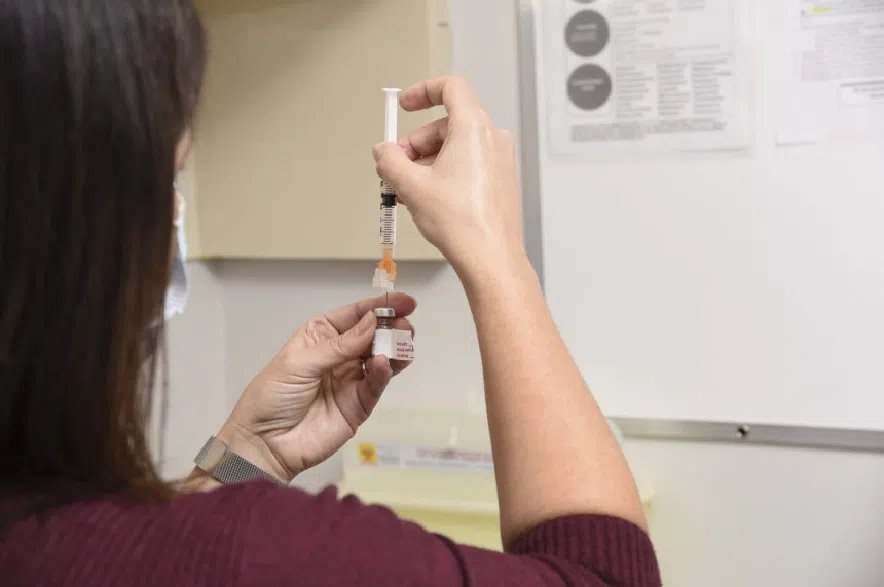Saskatchewan is testing out a new model for health clinics.
The new clinics will be independently operated, publicly funded and staffed by nurse practitioners.
Nurse practitioners are registered nurses with advanced training allowing them to perform exams, diagnose and treat health issues, and order lab work.
The announcement was made by Premier Scott Moe, Health Minister Everett Hindley and MLA Terry Jenson on Tuesday morning in Warman, where a local clinic is already run by nurse practitioners.
A new facility is currently being built in Martensville and is expected to open in April. It will have similar operation and staffing as the current Warman facility.
Moe explained Warman and Martensiville were chosen because of the fast-growing populations in both cities.
“By creating more opportunities for nurse practitioners throughout the health-care system, we can improve access to primary health-care services for Saskatchewan patients and their families,” Moe said in a media release.
Moe stressed that the extensions are meant to provide additional or enhanced health-care services for the province, with no “out-of-pocket fees” for those who use them.
The Ministry of Health said the new model of clinic, which is to be tested in a pilot program, will expand the role of nurse practitioners throughout the health-care system, and further opportunities to expand their role even further – including in primary care – are being examined.
The ministry is also adding more nurse practitioners to the provincial system.
“To improve access to primary health care in rural, regional, and northern communities, 25 new nurse practitioner positions will be created over the next year under the SHA, including in SHA clinics and as part of primary health care teams,” the Ministry of Health said in a statement.
“The ministry will work collaboratively with the SHA, the Saskatchewan Association of Nurse Practitioners and other primary care stakeholders toward implementing these initiatives.”
Hindley said Tuesday’s announcement is just a starting point, and the province could look at expanding the positions with the growing population and aging demographic.
“What we’re trying to do is make sure that we provide more opportunities for people to be able to access their health care,” Hindley said. “Maybe it’s a family doctor (or) maybe it’s a nurse practitioner.”
The move comes as Saskatchewan works to address shortages of doctors and other health-care professionals. The province previously expanded the roles of pharmacists, nurse practitioners and advanced care paramedics by allowing them to provide additional services in order to improve patient care.
Hindley said the government’s plan to add 1,000 new workers to the system is making progress, thanks in part to nurse practitioners.
“Our Health Human Resources Action Plan is showing success in a number of rural, regional, and northern communities,” Hindley said in a statement.
“We are grateful to the nurse practitioners who have been part of this success, and we are pleased to be creating more opportunities for nurse practitioners across our province.”
The Saskatchewan Association of Rural Municipalities sounded the alarm last month about health-care staff shortages in rural areas, saying rural Saskatchewan is facing a “health-care crisis.”
According to Statistics Canada, since 2019, one in five Saskatchewan residents does not have a primary care provider.
SARM said there were “more than 30 underutilized or unemployed (nurse practitioners) in the province,” and called for more nurse practitioner positions to be created and the restoration of a training program for them.
Hindley said the costs associated with the initiatives are to be released in the provincial budget next week.
Michelle O’Keefe, president-elect of the Saskatchewan Association of Nurse Practitioners (SANP) and a nurse practitioner out of Indian Head, agreed the initiatives will be beneficial for health-care workers.
She explained that overcapacity stems from a lack of primary care workers.
According to a survey from the SANP in 2022, 35 per cent of nursing practitioners are employed part time, but want full-time employment. The survey also revealed that 9.6 per cent of respondents were not employed due to a lack of available positions in their communities.
O’Keefe said these publicly funded, private clinics can also break down financial barriers for health-care access.
“Anytime you are hearing of new job opportunities, and the ability to expand our practice into different areas, is an exciting opportunity,” she said.
NDP responds to announcement
NDP Health Critic Vicki Mowat issued a statement about the announcement, saying it was “pretty thin on details.” That said, Mowat noted the Opposition is “hopeful there could be something here.”
“My main question is: Why does this government wait for things to get so bad before they do anything?” she wrote. “Two hundred thousand people in Saskatchewan do not have access to a family doctor or nurse practitioner.
“According to the Canadian Institute of Health Information, Saskatchewan is losing more doctors to other provinces than we’re recruiting. Saskatchewan lost a net 35 physicians to other provinces in 2022, the second-highest loss among the provinces only next to Alberta.”
— With files from 650 CKOM’s Mia Holowaychuk











